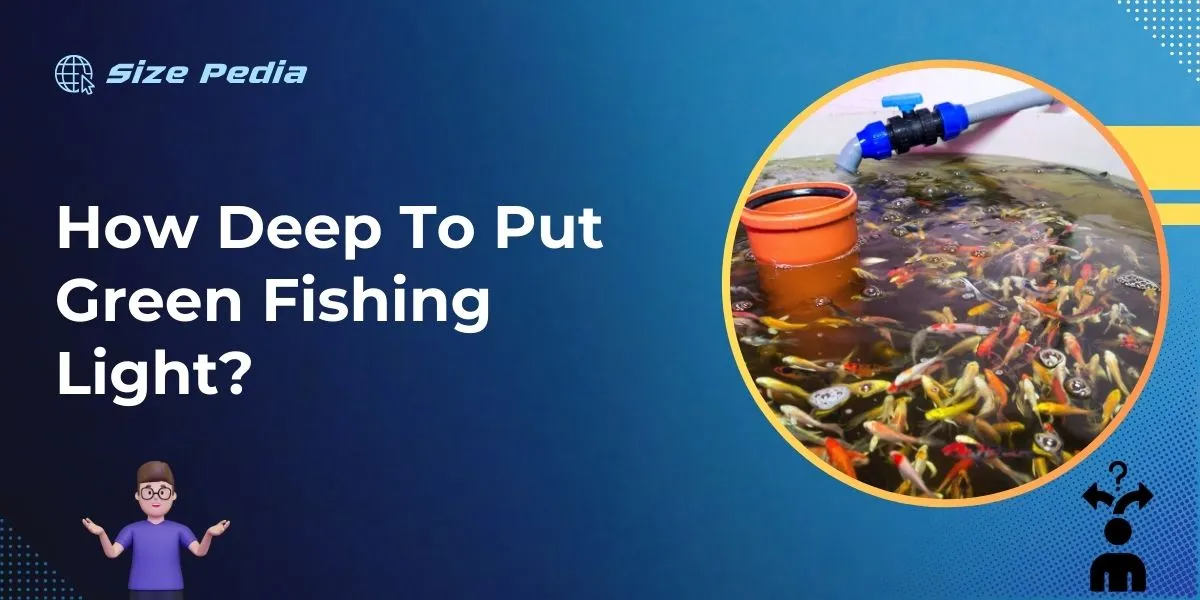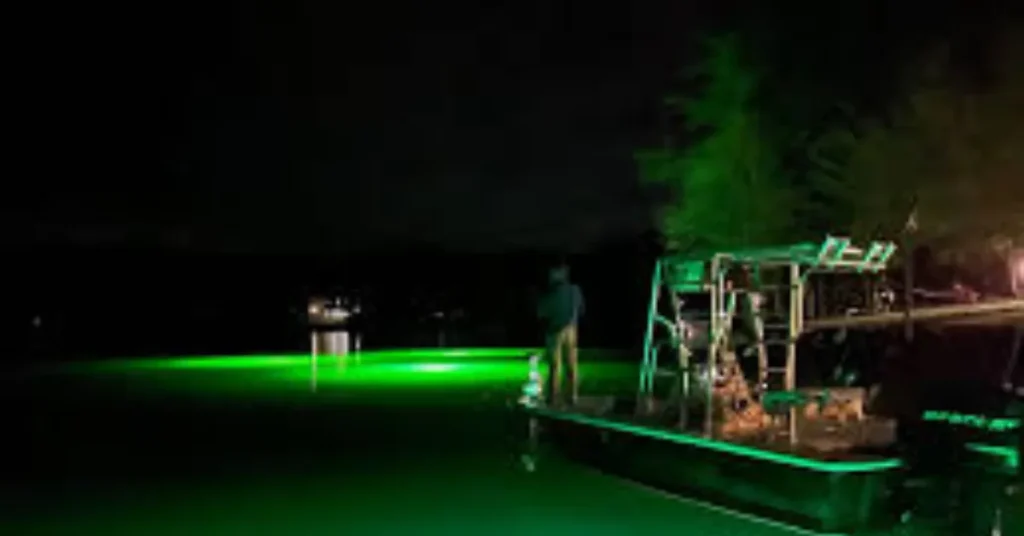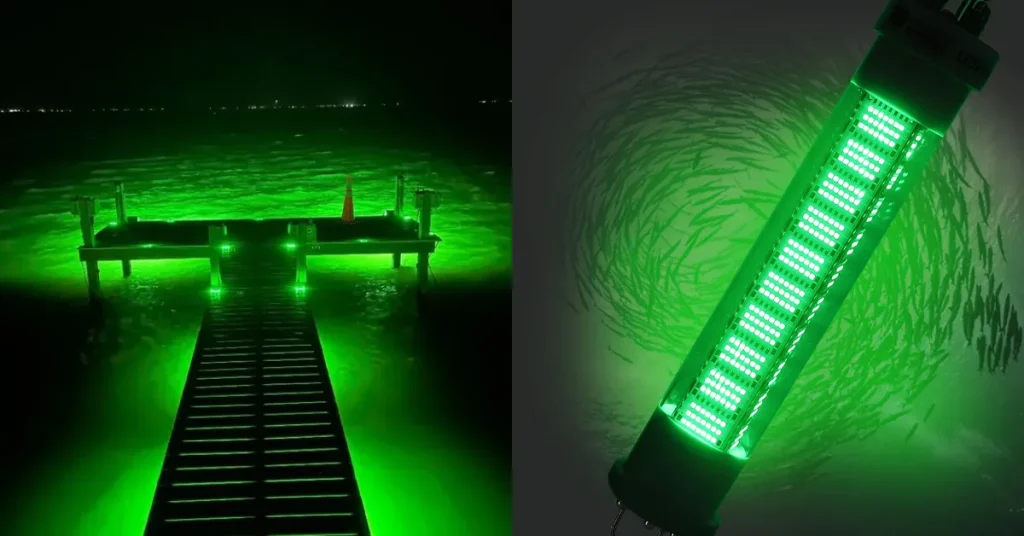Place your green fishing light 3 to 6 feet below the surface in fresh water, or at a depth where plankton is visible in salt water. Optimal depth varies depending on water clarity and local conditions.
Green fishing lights are essential tools for night-time anglers, enhancing visibility and attracting fish through the food chain reaction they trigger.
By illuminating the water with a specialized green light, microorganisms such as plankton flock towards the glow. This, in turn, attracts baitfish and ultimately draws in game fish seeking a meal.
Determining the correct depth for your green fishing light can substantially increase your chances of a successful catch. The task involves assessing water conditions, such as clarity and current, which can affect light penetration and plankton movements.
Expert anglers recommend experimenting with different depths to find the sweet spot where fish are most active. Embrace the luminous allure of green fishing lights to transform your nighttime fishing adventures.

Illuminating The Depths
Imagine a world underwater, awash with a soft green glow. An angler’s haven where green fishing lights beckon. This isn’t just a scene from a fantasy novel.
It’s the reality savvy fishermen create to lure and catch their prized trophies under the cloak of night.
The Purpose Of Green Fishing Lights
Green fishing lights serve a special purpose. They attract swarms of tiny creatures called phytoplankton. Small fish follow, hunting for a meal. Finally, big game fish swarm in, eyeing the smaller fish.
This natural food chain action works to an angler’s advantage, turning a good fishing spot into a great one.
- Increase visibility: Fishermen see through the water better.
- Attract marine life: From microorganisms to big fish, all are drawn to the light.
- Enhance fishing success: More fish mean more catches.
Factors Influencing Light Penetration
Different factors determine how deep you should place your green fishing light. It’s not just about depth but also clarity, conditions, and light intensity.
| Factor | Effect on Penetration |
| Water Clarity | Clearer waters allow deeper light penetration. |
| Murkiness | Murky waters require closer-to-surface placement. |
| Light Intensity | Stronger lights can be placed deeper. |
| Depth of Water | Shallower areas might benefit from light closer to the surface. |
Consider these factors, and you’ll maximize the draw of your green fishing light. The ideal placement? It varies, but starting between 3-7 feet below the surface is a good rule of thumb.
Adjust based on the factors above for the best results. Ultimately, the light should be deep enough to attract the target species but close enough to benefit from the attracted baitfish and the ambience it creates.
Casting The Light
Fishing adventures turn magical with green fishing lights. These lights draw fish closer, making your experience fruitful. The depth placement of your light plays a pivotal role.
Set the mood underwater for fish with the perfect green glow. Here’s the know-how to optimize your fishing light setup.
Types Of Green Fishing Lights
Green fishing lights come in various styles. Each one has a unique feature and a specific depth for best results.
- Submersible lights: Go deep to attract baitfish
- LED dock lights: Illuminate the water from above
- Portable lights: Used for temporary setups
Anchored Vs. Floating Lights: Placement Strategies
| Light Type | Placement | Depth |
| Anchored Lights | Fixed to a dock or heavy weight | 3-6 feet for clear water, 6-10 feet for murky |
| Floating Lights | On the water’s surface | Adjust depth with a tethered line |
- Anchored lights create a consistent zone for fish.
- Floating lights offer flexibility and mobility.
Consider the water’s clarity and current to determine the best light placement. Clear waters require deeper placement to spread the glow further.
Murky waters work well with lights positioned higher. Always ensure the light faces the water’s depth. This strategy will maximize your fishing success.
Navigating The Depths

Mastering the placement of a green fishing light is key to a successful catch. The right depth varies by conditions. Understanding these can transform an average fishing trip into an extraordinary one.
Lights attract fish at certain depths. Knowing where to place them gives anglers an edge. We delve into the factors that dictate the perfect depth.
Seasonal Water Clarity Considerations
Water clarity shifts with the seasons. Summer algae blooms may reduce visibility. This calls for a shallower light placement. In winter, water tends to be clearer. Lights can be placed deeper. Use these tips to adjust:
- Summer: Place lights 3-6 feet deep.
- Autumn: Start deeper, then adjust as needed.
- Spring: Consider rain impact and adjust.
- Winter: Aim for 10-12 feet but monitor clarity.
Understanding Water Column Stratification
Water layers, or stratification, affect light penetration. Upper layers might be warmer with more fish activity. Lower layers could be cooler. Find the active layer using these steps:
- Begin just below the surface.
- Gradually lower the light to find active fish.
- Observe the fish’s response at each depth.
Conduct a simple test for stratification before starting:
| Depth | Water Temperature | Fish Activity |
| Surface – 5 ft | Warm | High |
| 6 ft – 12 ft | Moderate | Medium |
| Below 12 ft | Cool | Low |
Proper depth maximizes the effectiveness of your green light. It helps you target the right zone for the catch. Always adapt to the water’s natural layers.
Targeting Aquatic Life
Anglers know that a green fishing light is a secret weapon for a successful catch. The right depth setting for your green fishing light maximizes the allure for different fish species.
Understanding how deep to position this glowing attractor helps turn your fishing trip into a night-time adventure.
Attracting Bait Fish
Bait fish love the cover of darkness. But a green light entices them. To draw these fish near your boat or dock, consider these tips:
- Shallow Waters: Place the light 1-3 feet deep in areas under 10 feet.
- Moderate Depths: If the water is 10-20 feet, position your light 3-6 feet below the surface.
- Clear Visibility: Ensure the light penetrates well. Clear water may require deeper placements.
Luring Predator Fish
Predator fish follow their food. When bait fish swarm to your light, predators are sure to follow:
- Deeper Settings: Place lights 6-10 feet down in deeper water to tempt predators.
- Edge of Darkness: A light set near shadows allows ambush points for predator fish.
- Submerged Structure: Near reefs or wrecks, position the light above the structure.
Each species has a preferred depth range. Test different depths for optimal results.
Real-world Insights
The mystery of setting the perfect depth for a green fishing light often involves a splash of science and a pinch of local wisdom. We’re diving deep into real-world insights that have helped night anglers illuminate their path to an unforgettable catch.
Let’s uncover what avid anglers say about the best practices to position your green fishing light for a bountiful haul.
Angler Experiences
- Shallow Waters: Many anglers find placing lights just 2-3 feet deep attracts smaller baitfish.
- Deep Waters: In deeper settings, lights set at 10-12 feet can lure in larger game fish.
- Water Clarity: Murky waters may require lights closer to the surface to be effective.
- Moon Phase: Darker nights often mean lights can work better slightly deeper.
Recommended Depths By Region
| Region | Depth Range |
| Gulf Coast: | 3-6 feet |
| Atlantic Coast: | 4-7 feet |
| Inland Lakes: | 2-5 feet |
| West Coast: | 5-8 feet |
Remember, these depths can vary based on local conditions. Test different depths to see what works best for your area.
Fine-tuning For Success

Mastering the art of using green fishing lights can make your fishing trips more productive. Optimal placement of your light ensures the best visibility and attraction of fish.
Getting the depth right is crucial for success. Let’s dive into tips and tricks for fine-tuning your setup for the ultimate fishing experience.
Adjusting Depth According To Conditions
Depth adjustment is key to attracting fish with a green fishing light. Various conditions dictate how deep you should go:
- Water clarity: In clearer water, place your light deeper to expand the illuminated zone.
- Time of night: Fish may go deeper as the night progresses. Adjust your light accordingly.
- Fish species: Different fish prefer different depths. Know your targets.
Start shallow and gradually go deeper until you spot action. Remember, lights set at the wrong depth could leave you in the dark regarding fish attraction.
Monitoring Success And Making Changes
Being attentive to your fishing light’s performance is essential. Keep an eye out for:
- Activity indicators: Fish movement and bait ball formations give clues.
- Light penetration: Check how well the light spreads underwater.
- Adaptability: Be ready to raise or lower your light throughout the night.
Logging your observations can be extremely helpful. Note the depth changes that led to better results. Adapt your tactics as needed to keep the fish coming.
FAQs About How Deep To Put Green Fishing Light
What Is The Ideal Depth For A Green Fishing Light?
The optimal depth for placing a green fishing light typically ranges from 3 to 10 feet underwater. It allows maximum attraction for fish by illuminating a broader area without being too close to the water’s surface, which can redirect fish away due to surface activity.
Does Water Clarity Affect Green Light Placement?
Yes, water clarity significantly impacts the placement of green fishing lights. In clearer water, lights can be placed deeper to attract fish from a greater distance. In murkier water, keep the light closer to the surface to ensure sufficient light penetration and visibility for an effective fishing area.
Can Green Fishing Lights Be Used In Saltwater?
Absolutely, green fishing lights are effective in both freshwater and saltwater environments. They attract baitfish and, subsequently, predatory fish, enhancing the fishing experience. Ensure the light is corrosion-resistant for durability in the saltwater conditions.
How Does Green Light Attract Fish At Night?
Green light is exceptional for night fishing as it’s less disturbing to fish and attracts zooplankton, which in turn draws in baitfish followed by larger predators. The green wavelength penetrates well in water, creating an effective feeding ground for fish.
Conclusion
Selecting the optimum depth for your green fishing light can significantly enhance your nighttime fishing success. Aim for the depths where fish gather, typically between three to six feet. This strategic placement ensures a bright, alluring underwater haven for your aquatic targets.
Happy fishing, and may your line be ever busy with the glimmering dance of fish drawn by your well-positioned beacon.
Resources:
1. https://www.smithsonianmag.com/innovation/these-light-fishing-nets-could-save-sea-turtles-180958634/
